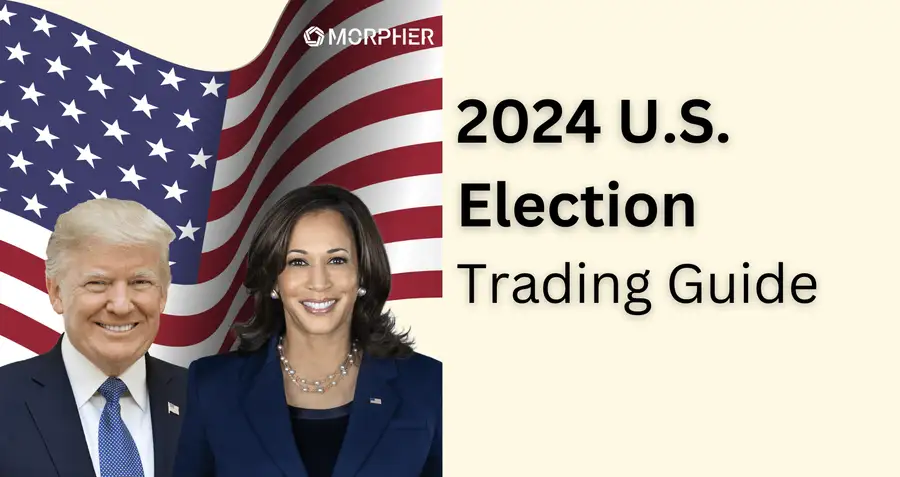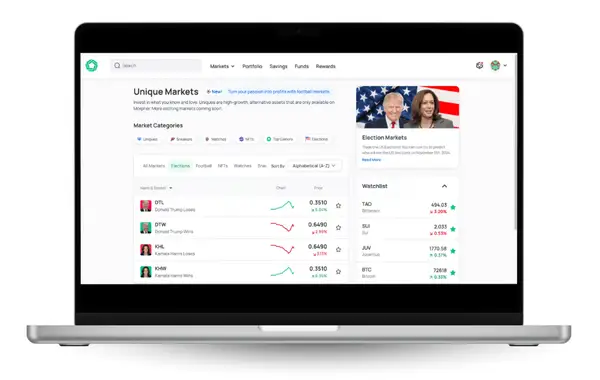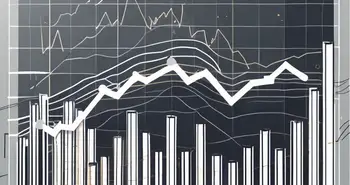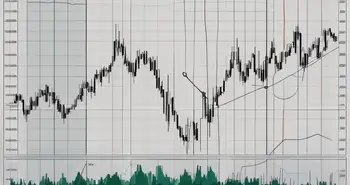Trading the 2024 US Election: Insights and Market Impacts for Global Investors

Election season is always a time of mixed anticipation and excitement, but when the event is as significant as the U.S. presidential election, its impact is felt far beyond American borders. The upcoming U.S. elections are not only a pivotal moment in domestic politics but are also a key driver of global market trends—this time, particularly in the cryptocurrency space, where new regulations are expected. With this election on the horizon, traders and investors around the world are closely watching, seeing it as a potential catalyst for the much-anticipated 2024 crypto bull market.
At Morpher, we’ve introduced a new market where users can trade on the outcomes of the U.S. elections, specifically allowing trades on four key scenarios: Donald Trump winning or losing and Kamala Harris winning or losing. This article will help you understand the key questions surrounding the election’s implications for international investors, providing financial analysis overview and insights based on current media reports.
This isn’t about politics—it’s about understanding how these political shifts can impact global markets and helping you feel prepared to trade confidently in our new U.S. election market on Morpher.

When is the U.S. Election 2024? The Voting Process and What Comes After
The U.S. presidential election is set for November 5, 2024, and it’s shaping up to be a significant event with prominent candidates from both major parties. On the Democratic side, we have Vice President Kamala Harris running for her party's nomination, while Donald Trump, the former president and a major Republican figure, is seeking re-election.
As we get closer to the election date, the race appears tight. Polls show head-to-head competition between the candidates, with recent surveys indicating that both Trump and Harris enjoy strong support within their respective bases. However, the outcome remains uncertain as key issues continue to sway voter sentiment.
How Does the U.S. Election Process Work?
On Election Day, voting takes place nationwide, usually from 7 a.m. to 8 p.m. local time, although specific hours can differ by state.
Once the polls close, vote counting begins. We often see initial results reported on election night, but the final tally can take days or even weeks, especially in states that permit mail-in voting or have large populations. This delayed counting can cause fluctuations in results as additional ballots are processed, particularly in battleground states where the race might be too close to call.
It’s important for us to remember that making definitive assessments about the election’s impact based solely on election night results can be misleading. Market reactions may vary, and the final outcomes can shift as more votes are counted and certified.
As results come in, media outlets and election monitoring organizations will provide continuous updates. However, the official certification of results is handled by each state’s election office, a process that can extend into December to ensure that every valid vote is counted accurately.
For non-U.S. traders, being aware of this timeline is essential, as market reactions can evolve over time based on early reports, late-breaking developments, and the overall uncertainty surrounding the election.
To stay ahead during this crucial period, we recommend checking Morpher AI’s real-time market insights to stay informed with the latest updates.

If Trump Wins

If Donald Trump secures the 2024 U.S. presidential victory, we can expect immediate waves of change impacting both domestic and global markets. His strong pro-business stance, built on tax cuts and deregulation, could boost investor confidence and drive bullish sentiment in sectors like finance and energy. Trump’s plan to extend the 2017 tax cuts, which heavily benefited higher-income individuals and corporations, could further enhance corporate profits. For us as traders, that might mean favorable conditions for energy and financial stocks, as well as consumer spending driven by his proposal to remove taxes on tips and social security benefits.
However, Trump’s tariff-heavy approach to trade is something we need to keep an eye on. His proposal to implement a 60% tariff on Chinese imports and significant tariffs on goods from other nations, such as Ireland, could disrupt global trade. This could introduce volatility into markets tied to international supply chains, so we’ll need to stay alert and adapt quickly. The Guardian notes that Trump’s plans could contribute to “a shift in power in the global economy,” underscoring the potential for major realignments in international trade.
One intriguing shift under a Trump administration could be his evolving stance on cryptocurrency. Unlike his previous skepticism, his current campaign embraces Bitcoin donations, and he’s even talked about building a government Bitcoin reserve. According to The New York Times, Trump aims to make the U.S. “the crypto capital of the planet.” This move could trigger an early crypto bull run, which might be an opportunity to capitalize on. However, traders should stay cautious—while the initial market reaction could be strong, the sustainability of this potential bull run is uncertain and may depend on broader regulatory and economic factors.
Geopolitics will also play a significant role. Trump’s promises, such as ending the war in Ukraine “on day one,” could mean dramatic policy shifts that might unsettle international markets. If we trade in sectors influenced by European stability, we should prepare for potential market fluctuations as his foreign policies unfold. His willingness to engage with figures like Vladimir Putin could add complexity to the geopolitical landscape, affecting market sentiment.
Trump’s stance on energy is another area where we might see big changes. His focus on boosting domestic production and cutting regulations could benefit traditional energy stocks and lower energy prices. However, it could also slow the growth of renewable energy sectors, which we should consider when planning long-term investments.
If Harris Wins

A Kamala Harris victory would likely signal a continuation and potential expansion of Biden-era policies, focusing on progressive reforms and international cooperation. Her economic approach, which prioritizes support for lower- and middle-income families, could mean a boost in consumer-driven sectors. Policies like a $6,000 tax credit for parents and a $50,000 tax break for small businesses are designed to fuel spending and economic participation from the ground up. For us as international traders, this could create steady growth opportunities, though it might come with higher taxes on wealthy individuals and corporations, leading to mixed market reactions.
Harris’s opposition to Trump’s high tariffs suggests a more cooperative trade environment. This could mean fewer shocks and disruptions in global trade, making it easier for us to plan and navigate investments with more predictability. Stability in trade policy is always welcome news, as it reduces the kind of uncertainty that can create sudden market swings.
Her foreign policy approach leans on building strong alliances and supporting geopolitical stability. Harris’s commitment to Ukraine, for instance, aligns with existing U.S. strategies to counter Russian aggression and ensure European security. This reassurance could bolster confidence in markets tied to defense and international commerce. As The Guardian mentions, Harris's approach may be seen as a stabilizing force that contrasts with Trump’s more disruptive strategies.
When it comes to energy, Harris would continue Biden’s focus on renewable energy investments and job creation through the Green New Deal. This could signal that we should watch green tech stocks and sustainable investment opportunities closely. Although Harris has stated she won’t ban fracking, her past comments on limiting it might cause some caution among traditional energy investors. However, her dedication to clean energy could attract international interest and create long-term growth in this sector.
Overall, a Harris administration would likely create a more predictable economic landscape with a focus on sustainability, consumer benefits, and strong international partnerships. While it may not spark the kind of immediate market surge we might see under Trump, it could lay the groundwork for long-term, stable growth. For us as traders, positioning ourselves in sectors aligned with her policies—such as renewable energy and consumer-focused industries—could offer promising opportunities.
Want to join the heated US Election 2024 debate without casting a vote? Back your candidate on Morpher and turn your predictions into potential profits!
As the countdown to November 5th accelerates, Morpher's US Election Market lets you transform political uncertainty into financial opportunity. With transparent and accessible trading, engage in the election conversation without impacting the market odds.
Don’t just sit back and watch—get in on the action with Morpher and claim your welcome bonus!

U.S. Dollar Forecast
The 2024 U.S. presidential election could have significant effects on the U.S. dollar, impacting global currency markets and investment strategies for non-U.S. traders. A Trump victory might initially strengthen the dollar due to pro-business policies like tax cuts and deregulation, but could lead to volatility from aggressive trade measures and high tariffs, which might disrupt global trade and investor sentiment.
Conversely, a Harris win would likely bring steady performance for the dollar, supported by cooperative trade policies and economic stability. Her approach would minimize trade conflicts, fostering a predictable environment that supports long-term confidence in the U.S. currency.
Non-U.S. traders should prepare for potential short-term opportunities and volatility under Trump, while expecting stability and consistent growth under Harris.
Historical Examples
Looking back at previous elections can provide valuable insights into market behavior and how political outcomes can influence investor sentiment and trading strategies.
2016 Election
The 2016 U.S. presidential election was marked by significant market fluctuations following Donald Trump’s unexpected victory. On election night, U.S. stock futures initially plummeted as traders reacted to the news, with concerns about potential instability and economic uncertainty. However, this negative sentiment quickly reversed, and the markets rallied, leading to what is often referred to as the “Trump Rally.” Investors became optimistic about Trump's promises of tax cuts, deregulation, and infrastructure spending, which they believed would stimulate economic growth. By the end of 2016, major indices like the S&P 500 and the Dow Jones Industrial Average had reached record highs.
2020 Election
The 2020 election was characterized by initial volatility as well, with markets reacting to the uncertainty surrounding the outcome, especially amid the COVID-19 pandemic. On election night and in the days that followed, stock markets experienced fluctuations as ballots were counted and the race between Joe Biden and Donald Trump unfolded. However, once it became clear that Biden was likely to win, markets adjusted to the prospect of a new administration focused on substantial fiscal stimulus and public health measures. The announcement of vaccine efficacy shortly after the election further boosted market sentiment, leading to a rally in stocks, particularly in sectors like travel, leisure, and energy.
How Can A Trader Get Ready for the Election
With the election day fast approaching, it's already clear that the political shifts will impact our individual portfolios. These volatile times can present significant risks, but when assessed correctly, they can also open up profitable opportunities. While navigating this uncertainty may not be easy, we’ve gathered a few straightforward steps to guide you through the heat of the 2024 U.S. elections.
Stay Informed with Real-Time Market Data: Use reliable sources like Morpher’s real-time market insights to stay updated on how the election developments impact various markets, including stocks, cryptocurrencies, and Forex. Keeping track of these shifts will help you make informed trading decisions as news breaks.
Diversify Your Portfolio: Ensure that your investments are spread across different asset classes to minimize risk. With Morpher, you can access a variety of markets—such as commodities, cryptocurrencies, and equities—all from one platform. This strategy can help cushion your portfolio against sudden market changes.
Leverage Advanced Charting Tools: Equip yourself with tools that allow you to analyze key indicators and trends. Advanced charting can help identify potential market movements and prepare you for quick decision-making as new information becomes available.
Engage in Election Prediction Markets: Take advantage of unique opportunities, like Morpher’s election market, where you can predict the outcomes of the 2024 U.S. election.
Implement Strong Risk Management: Prepare for election-driven volatility by setting stop-loss and take-profit orders. This will help manage your risk exposure and safeguard your investments during unpredictable market swings.
Final Thoughts
In conclusion, the U.S. elections hold significant implications not only for American citizens but also for traders and investors around the globe. We’ve aimed to equip you with all the essential tools and insights to navigate the evolving market landscape as the political environment shifts. With the U.S. Elections 2024 on the horizon, it's time to put that knowledge into action. Stay informed, diversify your investments, and leverage Morpher’s powerful features to ensure you're ready to seize opportunities and manage risks in this dynamic market. Get ready to make your mark this election season!
Frequently Asked Questions (FAQ)
1. When is the 2024 U.S. presidential election?
The 2024 U.S. presidential election is set for November 5, 2024.
2. Who are the main candidates for the 2024 U.S. election?
The main candidates for the 2024 U.S. presidential election are Vice President Kamala Harris for the Democratic Party and former President Donald Trump for the Republican Party.
3. When are the election results typically announced?
Initial results are often reported on election night, but the final tally can take days or weeks, especially in states that allow mail-in voting or have large voter turnouts. Official certification of results can extend into December as each state verifies and certifies their counts to ensure accuracy.
4. How do U.S. elections impact international investors?
U.S. elections can significantly influence global markets through changes in fiscal policies, trade agreements, and overall market sentiment. New leadership can affect market stability, currency valuations, and international investment flows, influencing sectors worldwide.
5. How could a Trump victory affect global markets?
A Trump win might initially boost the U.S. dollar and stock markets due to pro-business policies like tax cuts and deregulation. However, potential trade tensions from tariff-heavy policies could lead to volatility, affecting international markets tied to global trade.
6. How could a Harris victory influence market trends?
A Kamala Harris win would likely continue Biden-era policies, promoting stability in global markets. Her approach to cooperative trade policies and renewable energy investments could lead to consistent growth in related sectors, supporting a stable U.S. dollar.
7. Why is the 2024 U.S. election significant for cryptocurrency investors?
If Trump wins, his pro-crypto stance, including potential policies like creating a government Bitcoin reserve, could stimulate a crypto bull run. A Harris administration might adopt a cautious regulatory approach, fostering moderate but stable crypto market growth.
8. How did past U.S. elections impact global markets?
The 2016 election saw market fluctuations and a quick rally after Trump's unexpected win, while the 2020 election experienced initial volatility that stabilized as Joe Biden's administration promised fiscal stimulus and effective public health measures.
9. How can Morpher help traders navigate election-driven market changes?
As international investors navigate the complexities of U.S. elections and their global impact, having the right trading platform can make all the difference. Morpher.com stands out as a revolutionary choice, offering zero fees, infinite liquidity, and the ability to trade a wide range of asset classes, including stocks, cryptocurrencies, forex, and more. With features like fractional investing, short selling without interest fees, and up to 10x leverage, Morpher empowers you to take advantage of market opportunities in times of uncertainty. Experience the future of trading with Morpher's unique blockchain-based platform. Sign Up and Get Your Free Sign Up Bonus today, and be prepared for whatever the next U.S. election cycle may bring.

Disclaimer: All investments involve risk, and the past performance of a security, industry, sector, market, financial product, trading strategy, or individual’s trading does not guarantee future results or returns. Investors are fully responsible for any investment decisions they make. Such decisions should be based solely on an evaluation of their financial circumstances, investment objectives, risk tolerance, and liquidity needs. This post does not constitute investment advice.

Painless trading for everyone
Hundreds of markets all in one place - Apple, Bitcoin, Gold, Watches, NFTs, Sneakers and so much more.

Painless trading for everyone
Hundreds of markets all in one place - Apple, Bitcoin, Gold, Watches, NFTs, Sneakers and so much more.









